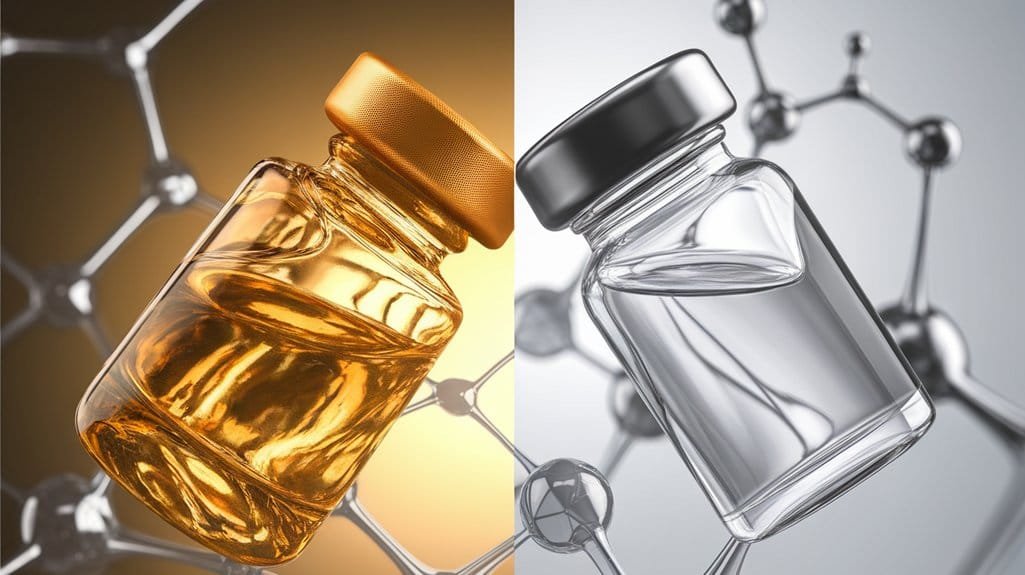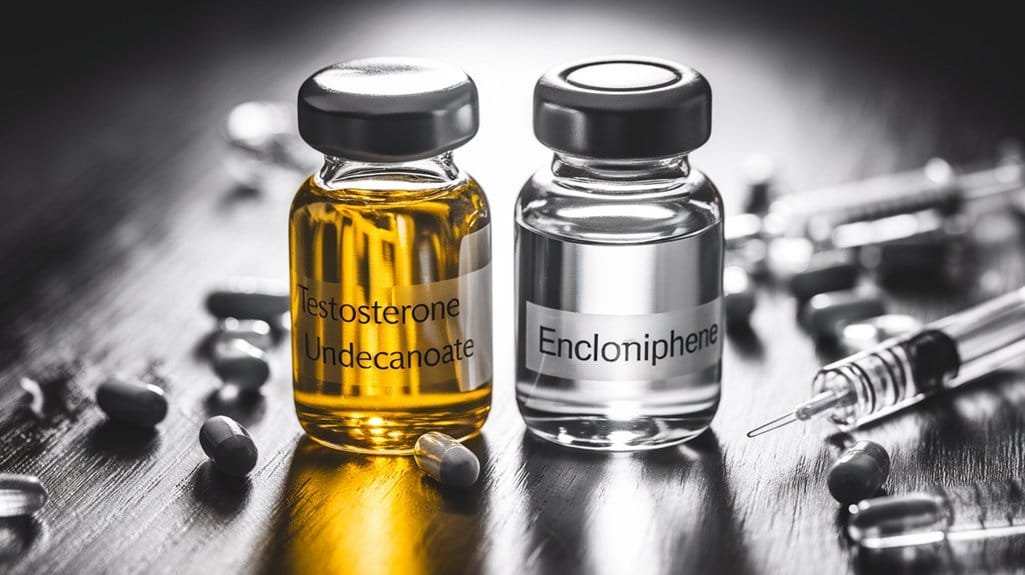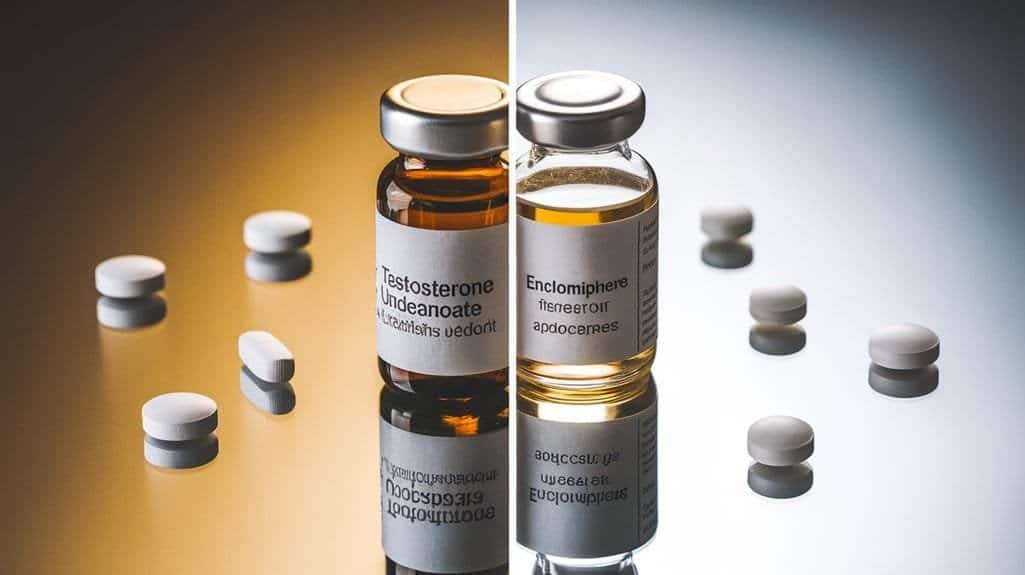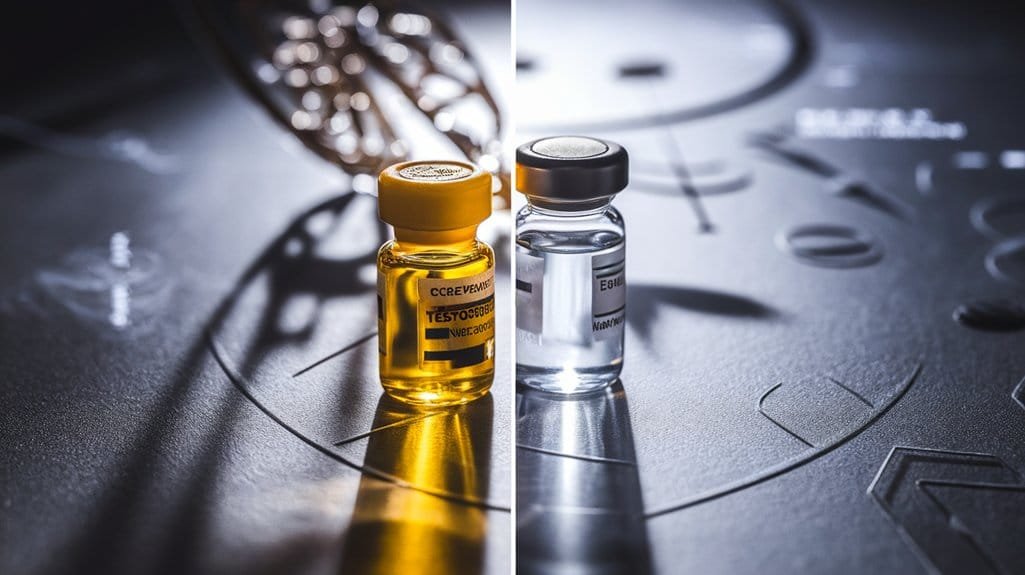Testosterone undecanoate acts as a prodrug that raises testosterone levels but considerably impairs sperm production, making it unsuitable for men wanting to conceive. In contrast, enclomiphene preserves fertility by boosting natural testosterone without reducing sperm count. While undecanoate can quickly enhance testosterone, it carries severe side effects. Enclomiphene generally has milder effects and promotes hormonal balance. If you're weighing your options, understanding the nuances of each therapy can guide your decision on what's best for you.
Key Takeaways
- Testosterone undecanoate significantly impairs sperm production, making it unsuitable for men planning to conceive, while enclomiphene preserves fertility and natural testosterone levels.
- Enclomiphene stimulates the release of gonadotropin-releasing hormone, boosting natural testosterone production without compromising fertility, making it ideal for younger men.
- Testosterone undecanoate is more appropriate for older men seeking quick symptom relief but comes with severe side effects and potential long-term health risks.
- Enclomiphene has milder side effects compared to testosterone undecanoate, making it safer for long-term use while avoiding testicular shrinkage or decreased sperm count.
- Treatment choice should reflect individual fertility goals and health priorities, with enclomiphene being preferable for those focused on reproductive health.
Mechanism of Action

When comparing the mechanisms of action of testosterone undecanoate and enclomiphene, it's clear that they operate through different biological pathways.
Testosterone undecanoate serves as a prodrug, converting to active testosterone through non-specific esterases. This testosterone binds to androgen receptors, promoting testosterone benefits such as increased lean body mass, improved sexual function, and enhanced bone density. TRT addresses testosterone deficiency in men, making it an essential consideration in treatment choices.
In contrast, enclomiphene acts as a selective estrogen receptor modulator, blocking estrogen receptors in the hypothalamus. This leads to increased gonadotropin-releasing hormone release, amplifying natural testosterone production.
Enclomiphene advantages include maintaining hormonal balance without introducing exogenous testosterone, minimizing side effects while promoting endogenous testosterone levels.
Ultimately, both therapies can meaningfully impact hormonal health but through distinctly different mechanisms.
Effect on Fertility
When considering fertility, testosterone undecanoate can greatly impair sperm production, making it unsuitable for men planning to conceive. In contrast, enclomiphene preserves spermatogenesis by stimulating the body's own testosterone production. Understanding these differences is essential for you when evaluating treatment options based on your fertility goals. The study indicated that variable suppression of spermatogenesis occurred in men treated with testosterone undecanoate, highlighting the need for careful consideration of its effects on fertility.
Fertility Preservation Potential
Understanding the fertility preservation potential of testosterone undecanoate and enclomiphene is essential for men considering treatment options. Testosterone undecanoate introduces exogenous testosterone, suppressing the hypothalamic-pituitary-gonadal axis, leading to reduced fertility—often resulting in azoospermia. In contrast, enclomiphene stimulates natural testosterone production, enhancing LH and FSH levels beneficial for spermatogenesis. Below is a comparison of their effects on fertility preservation:
| Treatment | Fertility Impact | Key Considerations |
|---|---|---|
| Testosterone Undecanoate | Significant suppression | Not suitable for fertility |
| Enclomiphene | Promotes natural production | Better for preserving fertility |
| Mechanism | Exogenous testosterone | Natural hormone stimulation |
| Azoospermia risk | High | Low |
| Ideal candidates | Older men, non-fertile | Men wanting children |
Considering these factors aids in making informed decisions regarding treatment. Additionally, research indicates that speriotypic suppression achieved by testosterone undecanoate can effectively maintain sperm count reduction even after prolonged administration.
Sperm Production Impact
Sperm production is greatly affected by the choice between testosterone undecanoate (TU) and enclomiphene, particularly for men considering their fertility options.
TU is effective in suppressing spermatogenesis, often reducing sperm concentration below 1 million/ml within 12 weeks, with higher doses accelerating this suppression.
In contrast, enclomiphene stimulates the hypothalamus and pituitary gland, enhancing the release of LH and FSH. This mechanism preserves natural sperm production and hormonal balance, preventing testicular atrophy.
While TU leads to significant hormonal fluctuations that can substantially decrease sperm counts, enclomiphene maintains normal sperm levels and testicular function.
As such, if fertility is a priority, enclomiphene emerges as a more favorable option compared to TU.
Treatment Suitability Considerations
Choosing between testosterone undecanoate and enclomiphene involves careful consideration of their effects on fertility, depending largely on patient circumstances. Your treatment timing and age play critical roles in decision-making. Testosterone undecanoate may suppress natural testosterone and fertility, making it less suitable for younger patients or those planning a family. In contrast, enclomiphene promotes natural testosterone production without compromising fertility.
| Treatment | Patient Age Suitability | Fertility Impact |
|---|---|---|
| Testosterone Undecanoate | Older men (less fertility concern) | Potential suppression of spermatogenesis |
| Enclomiphene | Younger men (family planning) | Maintains or enhances fertility |
Efficacy Comparison

While both testosterone undecanoate and enclomiphene aim to improve testosterone levels, their efficacy and mechanisms of action differ markedly.
Testosterone undecanoate achieves normal serum testosterone levels in 94% of patients within a 10-week dosing interval, with significant improvements in energy and libido.
Enclomiphene, on the other hand, stimulates natural testosterone production and raises total testosterone levels within 14 days, albeit with gradual effects. While it maintains testosterone in a desirable range, it may not achieve results as swiftly as testosterone undecanoate.
Patient preferences regarding dosage forms play a vital role in treatment selection, as some may favor the injection schedule of testosterone undecanoate over daily enclomiphene administration, due to respective onset and maintenance of effects.
Administration Methods
Administration methods play a crucial role in the effective use of testosterone undecanoate and enclomiphene for testosterone supplementation.
Testosterone undecanoate requires precise intramuscular technique, administered slowly into the gluteus medius muscle using a 20G, 21G, or 22G needle. Typically, you'll inject every 10-14 weeks, with initial doses at 0 and 4 weeks to establish steady serum levels.
In contrast, enclomiphene employs oral administration, simplifying dosage adjustments without invasive techniques or the need for syringes. This method promotes natural hormone production and is tailored to individual needs, requiring no regular healthcare visits.
Monitoring remains essential for both methods, ensuring therapeutic effectiveness and minimizing risks associated with injection or oral use.
Side Effects

When considering testosterone supplementation options, it's essential to be aware of the potential side effects associated with both testosterone undecanoate and enclomiphene.
Testosterone undecanoate presents notable side effect severity, including serious risks like cardiac disorders and anaphylaxis, alongside common issues like acne and injection site pain. Long term consequences can include prostate-related conditions and polycythemia.
Conversely, enclomiphene generally exhibits milder side effects, such as acne and mood swings, with a much lower incidence of severe reactions. Importantly, it doesn't induce testicular shrinkage or decrease sperm count, enhancing long-term sexual health advantageously.
Ultimately, knowing these side effects helps you make an informed decision tailored to your health needs.
Safety Considerations
Understanding the safety considerations of testosterone undecanoate and enclomiphene is essential for making informed choices about supplementation. Both options exhibit distinct safety profiles.
Testosterone undecanoate may lead to increased prostate-specific antigen levels and hematocrit, alongside potential risks of high blood pressure and mood changes. It's vital to monitor signs of hepatic dysfunction, even without recommended liver function tests.
Conversely, enclomiphene is generally associated with fewer severe side effects, sparing fertility but occasionally causing mood swings. Regular monitoring strategies for enclomiphene users include evaluating testosterone levels and awareness of rare complications like breathing issues.
Ultimately, both therapies require vigilant oversight to optimize benefits while minimizing risks in your treatment journey.
Contraindications

Contraindications play an essential role in determining the suitability of testosterone undecanoate and enclomiphene for individual patients.
You shouldn't use testosterone undecanoate if you have allergies, androgen-dependent cancers, severe organ disease, or a history of liver tumors. Health implications include potential exacerbation of epilepsy or kidney and heart conditions, necessitating close monitoring.
For enclomiphene, known hypersensitivity, undiagnosed abnormal uterine bleeding, or active hormone-dependent tumors are disqualifiers. Additionally, if you're pregnant, it's contraindicated.
Be cautious about drug interactions, particularly with thyroid replacement therapy and immunosuppressants, as well as with lipid-lowering medications like statins.
Understanding these contraindications guarantees appropriate treatment choices and minimizes adverse health outcomes. Always consult your healthcare provider for tailored advice.
Suitability for Different Populations
Determining the suitability of testosterone undecanoate and enclomiphene for different populations requires careful consideration of individual needs and health conditions.
For younger men, enclomiphene is preferable as it stimulates natural testosterone production without affecting fertility, making it essential for those concerned about sperm preservation.
In contrast, older men often benefit from testosterone undecanoate, which delivers rapid improvements in testosterone levels and alleviates symptoms associated with low testosterone. Given that older men might prioritize symptom relief over fertility protection, testosterone undecanoate's injectable or oral administration provides flexibility.
Ultimately, evaluating each individual's health conditions and goals is essential in choosing the most appropriate treatment.
Treatment Goals and Preferences

When considering treatment options, you should weigh your goals for fertility preservation and hormonal balance.
If maintaining sperm production and natural hormone levels are priorities, you might lean towards enclomiphene.
Conversely, if you're looking for a quick boost in testosterone levels, testosterone undecanoate may be more appealing despite potential risks to fertility.
Fertility Preservation Considerations
Understanding fertility preservation considerations is imperative for individuals undergoing treatment for low testosterone levels. If maintaining fertility is a priority, you might find enclomiphene a more suitable option.
Unlike testosterone undecanoate (TU), which can suppress spermatogenesis, enclomiphene stimulates the release of LH and FSH, promoting natural sperm production. With enclomiphene, you have flexible treatment timing, tailored to your health goals without the high risk of infertility.
In contrast, TU's suppressive effects can considerably impact your fertility options, especially if administered periodically. It's vital to assess your fertility plans beforehand, as choosing the right therapy can influence your long-term reproductive health and success in preserving fertility while treating low testosterone.
Hormonal Balance Goals
Achieving hormonal balance involves setting clear treatment goals tailored to your unique needs and lifestyle. Whether you choose Testosterone Undecanoate or Enclomiphene, your aim should be to achieve ideal hormonal stability for improved therapeutic outcomes. Both interventions serve different purposes, and preferences can greatly impact your experience.
| Treatment | Goals |
|---|---|
| Testosterone Undecanoate | Restore testosterone levels to alleviate symptoms like libido loss and fatigue. |
| Enclomiphene | Maintain baseline testosterone levels without invasive procedures. |
| Both Options | Improve body composition and enhance energy levels. |
| Testosterone Undecanoate | Fewer injections lead to stable hormone levels. |
| Enclomiphene | Practical for those avoiding major lifestyle changes. |
Establish your priorities in consultation with your healthcare provider for the best results.
Frequently Asked Questions
Can Enclomiphene and Testosterone Undecanoate Be Used Together?
Yes, you can use enclomiphene and testosterone undecanoate together in combination therapies. This approach enhances your hormonal balance, promoting natural testosterone production while reducing side effects, thereby supporting overall testicular function and fertility outcomes effectively.
How Long Does It Take to See Results From Each Treatment?
Result timelines vary considerably; you'll likely notice changes within weeks to months. For ideal treatment expectations, consistent use and monitoring are essential to gauge efficacy and adjust dosages based on your individual response.
Are There Specific Lifestyle Changes to Support Treatment Effectiveness?
Think of your body as a finely tuned engine; dietary modifications and exercise routines fuel its performance. Implement balanced meals and consistent workouts to optimize effectiveness, enhance hormonal balance, and fortify overall health during treatment.
What Are the Costs Associated With Each Treatment Option?
When evaluating costs, consider long-term expenses and potential savings. Alternative therapies might offer lower overall costs, especially as they may reduce the necessity for ongoing treatments and minimize associated side effects and monitoring expenses.
Will Insurance Typically Cover These Treatments?
Maneuvering insurance coverage can be a delicate dance; typically, you'll find that both treatments require thorough documentation for treatment approval, confirming low testosterone levels, and evidence of medical necessity tailored to your specific circumstances.






